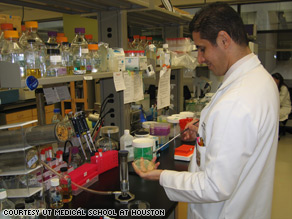Deadly U.S. superbugs spread to South America
- Story Highlights
- Superbugs that can cause lethal infections are hitting South America
- The germs are genetically related to two strains of bacteria found in the U.S.
- Researchers are tracking cases to understand how the organisms got there
- Next Article in Health »
For CNN
LONDON, England (CNN) -- Variations of two deadly superbugs that had previously only been discovered in the United States have surfaced in South America.

Variations of two U.S. strains of killer bacteria have cropped up in South America, researchers say.
The drug-resistant microorganisms are sweeping across communities in Colombia and have the potential to unleash devastating results, according to researchers at The University of Texas Medical School at Houston.
"The people of Colombia are not aware this is coming. It is killing people here and it is going to kill a lot of people there if we don't act quickly," Dr. Cesar Arias, one of the lead researchers of the study, told CNN.
The study, which was carried out with the Universidad El Bosque in Bogota, was published in the New England Journal of Medicine on Thursday.
The bugs that have emerged in Colombia are genetically related to two strains of bacteria -- MRSA and VREF -- that have spread across the United States.
MRSA, or methicillin-resistant Staphylococcus aureus, was once spread mainly in hospitals. In recent years, a number of people not in contact with hospitals have presented with the disease, which is a leading cause of severe skin infections in the United States.
VREF, which stands for vancomycin-resistant Enterococcus faecium, mainly arises in hospitals and infects people in critical care units.
Both so-called superbugs can cause lethal infections and are resistant to antibiotics.
There were no known cases of this type of MRSA in Colombia before 2005, and no cases of VREF before 2001, the study said.
Don't Miss
But a total of 15 MRSA infections have been reported in Colombia in recent years and some 50 cases of VREF have been identified since it was first documented in the country.
The MRSA strain has also been found in Ecuador and Venezuela.
For some reason, the bacteria in South America are acting in a similar way as their genetic forebears in the United States, Arias, who is an assistant professor of infectious diseases at the UT Medical School at Houston, said.
They are becoming more resistant and spreading the same way, Arias explained. "The dramatic thing is the first 15 patients who had this disease presented out of hospital, and 20 percent of these patients died," he said.
Researchers are tracking the cases to see how the organisms got to South America. The focus now, Arias said, is to establish the link between the two regions and to figure out how to control their spread.
All About Bacteria • South America

 Sit tight, we're getting to the good stuff
Sit tight, we're getting to the good stuff
